- Raspberries: Autumn Planting and Care, Pruning Your Complete Guide
- Introduction
- Autumn Planting
- Caring for Raspberries
- Pruning Raspberries
- Conclusion
- Benefits of Autumn Planting
- Choosing the Right Raspberry Variety
- Growing Zone
- Harvest Time
- Flavor Profile
- Growing Habit
- Disease Resistance
- Yield
- Table Comparing Raspberry Varieties
- Preparing the Soil for Planting
- 1. Choose a suitable location:
- 2. Clear the area:
- 3. Test the soil:
- 4. Improve the soil:
- 5. Adjust the pH:
- 6. Consider drainage:
- 7. Final soil preparation:
- Planting Raspberries in Autumn
- Choosing the Right Variety
- Preparing the Soil
- Planting
- Spacing
- Support
- Watering and Mulching
- Harvesting
- Maintenance and Pruning
- Pest and Disease Control
- Conclusion
- Caring for Raspberries in Autumn
- 1. Clearing the Area
- 2. Pruning
- 3. Fertilizing
- 4. Mulching
- 5. Winter Protection
- 6. Watering
- 7. Cleaning and Storing Garden Tools
- Pruning Raspberries for a Healthy Harvest
- 1. Prune in the late winter or early spring
- 2. Remove old and diseased canes
- 3. Thin out overcrowded canes
- 4. Cut back lateral branches
- 5. Train the canes
- 6. Clean up and mulch
- Troubleshooting Common Raspberry Problems
- 1. Yellowing Leaves
- 2. Wilting or Drooping Canes
- 3. Leaves with Tattered Edges
- 4. Mold or Fungal Disease
- 5. Lack of Fruit Production
- 6. Small or Misshapen Berries
- 7. Stunted Growth
- 8. Yellow or Brown Spots on Leaves
- Question-answer:
- When is the best time to plant raspberries?
- How do I care for raspberries in the autumn?
- Why is autumn planting beneficial for raspberries?
- When should I prune my raspberry plants?
- How should I prune my raspberry plants?
- Video: How To Grow Raspberry Bushes From Cuttings: Easy and Free@
Raspberries are delicious fruits that can be easily grown in your backyard. Whether you’re a gardening enthusiast or just starting out, this complete guide will walk you through the process of planting, caring for, and pruning raspberries in autumn.
In autumn, the cooler temperatures and moist soil create the perfect conditions for planting raspberries. Before planting, it’s important to choose a sunny spot in your garden with well-draining soil. Raspberries thrive in full sun and prefer soil that is rich in organic matter.
When it comes to planting raspberries, you have two options: bare-root plants or potted plants. Bare-root plants are dormant plants that are typically sold by mail-order nurseries. Potted plants, on the other hand, are available at most garden centers and can be planted throughout the year. Both options have their advantages, so choose the one that suits your preferences.
After planting your raspberries, proper care is essential for their growth and productivity. Regular watering is crucial, especially during dry spells. Mulching around the base of the plants with organic matter helps retain moisture and suppresses weed growth. Fertilizing with a balanced fertilizer in spring and early summer can also enhance the growth and fruit production of your raspberries.
Pruning is another important aspect of raspberry care. Pruning helps promote the growth of new canes and ensures a healthy balance between vegetative growth and fruit production. In autumn, after the harvest season, it is recommended to prune out any dead or diseased canes. This helps prevent the spread of diseases and allows for better air circulation within the plant. Additionally, reducing the number of canes can improve the size and quality of the fruit.
Important Tip: When pruning raspberries, always use clean, sharp tools to make clean cuts. This helps prevent the spread of diseases and ensures the health of your plants.
By following these tips for autumn planting, care, and pruning, you can enjoy a bountiful harvest of raspberries in your own backyard. Their sweet, tangy flavor and versatility make them a desirable addition to any garden and a tasty treat for the whole family.
Raspberries: Autumn Planting and Care, Pruning Your Complete Guide
Introduction
Raspberries are delicious and versatile fruits that can be enjoyed fresh, frozen, or used in a variety of recipes. Autumn is the perfect time to plant raspberries as the cooler weather allows them to establish their roots before winter. This complete guide will provide you with all the information you need for successful autumn planting and care of raspberries, as well as how to properly prune your plants for optimal growth and fruit production.
Autumn Planting
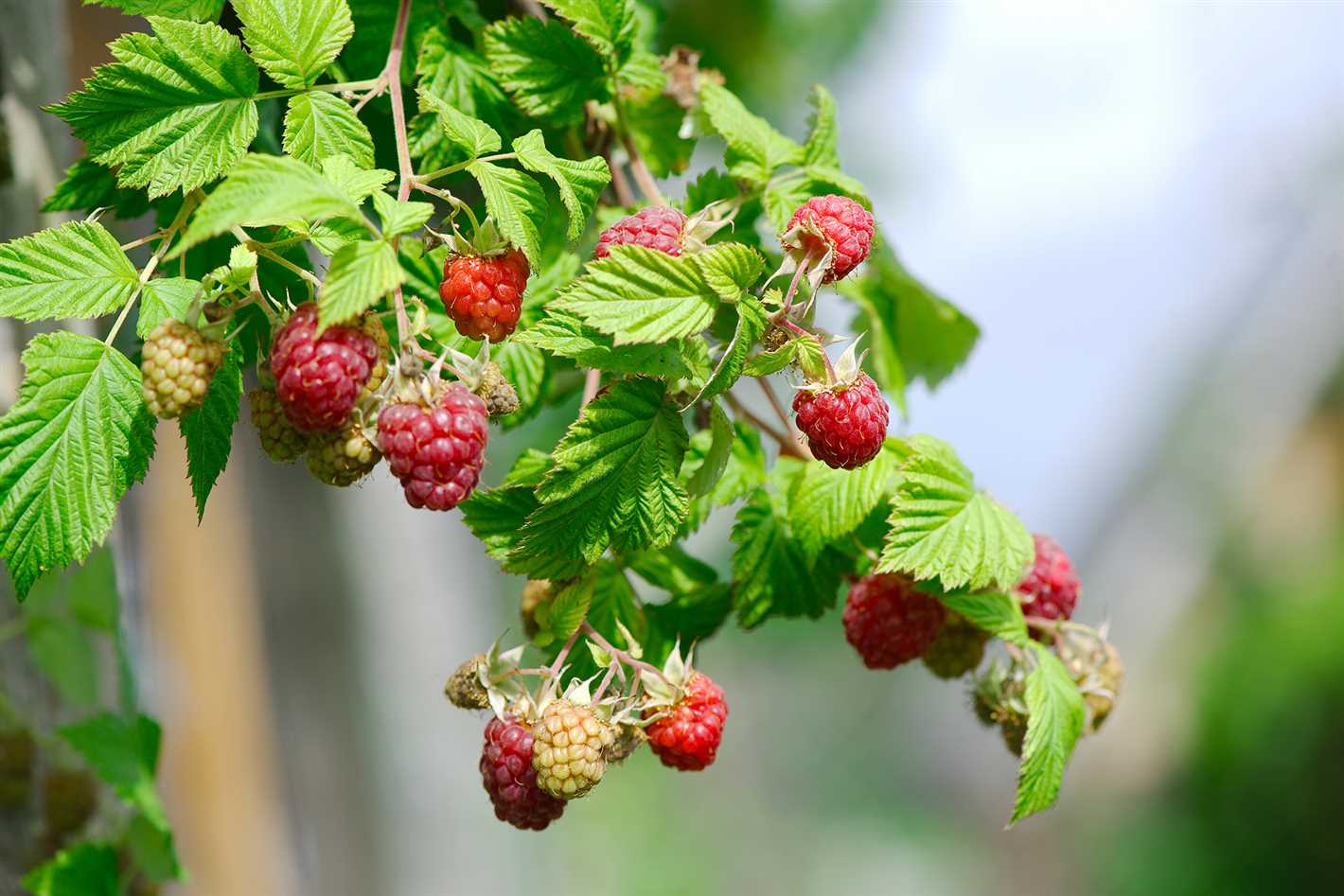
Autumn is the ideal time to plant raspberries because the soil is still warm and the roots have time to establish before the cold winter months. Here are some steps to follow for successful autumn planting:
- Choose a sunny location with well-draining soil for your raspberry plants.
- Prepare the soil by removing any weeds, rocks, or other debris. Loosen the soil with a garden fork or tiller to improve drainage.
- Dig a hole that is wide and deep enough to accommodate the roots of the plant. Place the plant in the hole, making sure that the crown is level with the soil surface.
- Backfill the hole with soil, firming it gently around the roots to remove any air pockets.
- Water the newly planted raspberry plants thoroughly.
Caring for Raspberries
After planting your raspberries, it’s important to provide them with proper care throughout the autumn season. Here are some tips:
- Water your raspberry plants regularly, especially during dry periods. Aim for about 1 inch of water per week.
- Mulch around the base of the plants to conserve moisture and suppress weed growth.
- Monitor for pests and diseases, and take appropriate action if necessary.
- Support the canes with stakes or a trellis to prevent them from bending or breaking under the weight of the fruit.
- Harvest the ripe berries regularly to encourage further fruit production.
Pruning Raspberries
Pruning is an important part of raspberry plant care as it helps promote healthy growth and higher yields. Here are some guidelines for pruning your raspberry plants:
- Prune your raspberries in late winter or early spring before new growth begins.
- Remove any dead or damaged canes at ground level.
- Thin out the remaining canes by cutting away weak or overcrowded ones, leaving only the strongest canes.
- Trim the remaining canes to a height of about 4-5 feet, cutting just above a bud.
- Dispose of the pruned canes to prevent the spread of diseases.
Conclusion
With proper autumn planting, care, and pruning, you can enjoy a bountiful harvest of raspberries. Follow the steps outlined in this complete guide to ensure your raspberry plants thrive and produce delicious fruit year after year.
Benefits of Autumn Planting
- Establishment: Planting raspberries in autumn allows for a longer establishment period before winter, giving the plants a better chance to establish strong root systems.
- Early Harvest: Autumn-planted raspberries have a higher chance of producing an early harvest the following summer, giving you a head start on enjoying your homegrown fruit.
- Less Watering: Cooler temperatures and higher moisture levels in autumn reduce the need for frequent watering, saving you time and resources.
- Reduced Pests and Diseases: By planting in autumn, you can potentially avoid some common pests and diseases that are more prevalent during the summer months.
- Opportunity for Restoration: Autumn planting provides an opportunity for restoring or rejuvenating existing raspberry plants that may have become overgrown or unhealthy. By starting fresh with new plants, you can ensure healthier and more productive future harvests.
- Winter Hardiness: Autumn-planted raspberries have more time to acclimate to winter conditions, increasing their chances of surviving the cold and harsh weather.
Overall, autumn planting offers several advantages for growing raspberries, including improved establishment, early harvest, reduced watering, and the opportunity for restoration. By taking advantage of the cooler temperatures and higher moisture levels, you can set your raspberries up for success and enjoy a bountiful harvest in the following year.
Choosing the Right Raspberry Variety
Choosing the right raspberry variety is crucial for growing a successful crop. Different varieties have different characteristics and are better suited for specific climates and growing conditions. Here are some factors to consider when selecting a raspberry variety:
Growing Zone
Raspberries are classified into different growing zones, based on their hardiness and ability to withstand cold temperatures. It is important to choose a variety that is suitable for your specific growing zone. Consult a local gardening guide or ask experts at your local nursery for information on which varieties thrive in your area.
Harvest Time
Raspberry varieties can be categorized into early, mid-season, and late varieties based on their harvest time. Early varieties produce fruit in early summer, while late varieties extend the harvest season into the fall. Consider how long you want the harvest season to be and choose varieties that will give you a continuous supply of berries throughout the desired period.
Flavor Profile
Raspberries can vary in flavor, from sweet and juicy to tart and tangy. Some varieties are known for their exceptional taste, while others are better suited for cooking or processing. Consider your preferences and whether you intend to eat the berries fresh or use them for specific culinary purposes.
Growing Habit
Raspberry plants can have either an upright or a trailing growth habit. Upright varieties are more compact and require less space, making them ideal for small gardens or containers. Trailing varieties, on the other hand, have longer canes that need support and more room to spread. Consider the available space in your garden and choose a variety that fits your needs.
Disease Resistance
Raspberries are susceptible to various diseases, including powdery mildew, root rot, and cane blight. Some raspberry varieties are bred to be more resistant to certain diseases while others may require more intensive care and management. Consider the prevailing diseases in your area and choose disease-resistant varieties to minimize the risk of plant loss.
Yield
The yield of raspberry plants can vary significantly between varieties. Some varieties are known for their high yield, while others may produce a lower quantity of berries. Consider the amount of raspberries you want to harvest and choose a variety that will meet your needs.
Table Comparing Raspberry Varieties
| Variety | Hardiness Zone | Harvest Time | Flavor Profile | Growing Habit | Disease Resistance | Yield |
|---|---|---|---|---|---|---|
| Red Gem | 4-8 | Early | Sweet | Upright | High | High |
| Heritage | 4-9 | Mid-season | Tart | Trailing | Medium | Medium |
| Autumn Bliss | 4-8 | Late | Sweet | Upright | High | High |
Remember to do thorough research and choose raspberry varieties that are best suited to your specific needs and growing conditions. This will ensure a bountiful harvest and a successful raspberry growing experience.
Preparing the Soil for Planting
Before planting raspberries in the autumn, it’s important to prepare the soil to provide the optimum growing conditions for the plants. Here are some steps you can follow to prepare the soil:
1. Choose a suitable location:
Find a well-drained area with full sun exposure for your raspberry plants. Raspberries prefer slightly acidic soil with a pH range of 5.5 to 6.5. Ensure that the site is away from trees and other tall plants that may shade the raspberries.
2. Clear the area:
Remove any existing vegetation, weeds, or debris from the planting site. Use a rake or a hoe to clear the area and create a clean space for the new raspberry plants.
3. Test the soil:
It’s recommended to test the soil before planting raspberries. You can use a soil testing kit or send a sample to a local agricultural extension office. The test results will provide information about the soil’s nutrient content and pH level. If necessary, you can amend the soil to improve its quality.
4. Improve the soil:
If the soil lacks essential nutrients, you can add organic matter such as compost or well-rotted manure. These organic materials will improve the soil structure, enhance its drainage, and provide necessary nutrients for the raspberry plants. Spread a layer of organic matter and mix it into the top 6-8 inches of soil using a garden fork or a tiller.
5. Adjust the pH:
If the soil pH is outside the recommended range for raspberries, you can adjust it by adding lime to increase the pH or sulfur to decrease the pH. Follow the instructions provided by the soil test or consult a gardening expert for the correct application rates for your soil type.
6. Consider drainage:
Raspberries do not thrive in waterlogged soil. If the site tends to retain water, you can improve drainage by creating raised beds or installing drainage tiles. This will allow excess water to drain away, preventing root diseases and other problems associated with poor drainage.
7. Final soil preparation:
After adding organic matter and adjusting the pH, use a rake to level the soil and break up any large clumps. Remove any rocks or debris that may interfere with the growth of the raspberry plants.
By following these steps to prepare the soil for planting, you can ensure that your raspberries have a healthy environment to grow and thrive. Good soil preparation will promote vigorous growth and maximize your chances of a successful harvest.
Planting Raspberries in Autumn
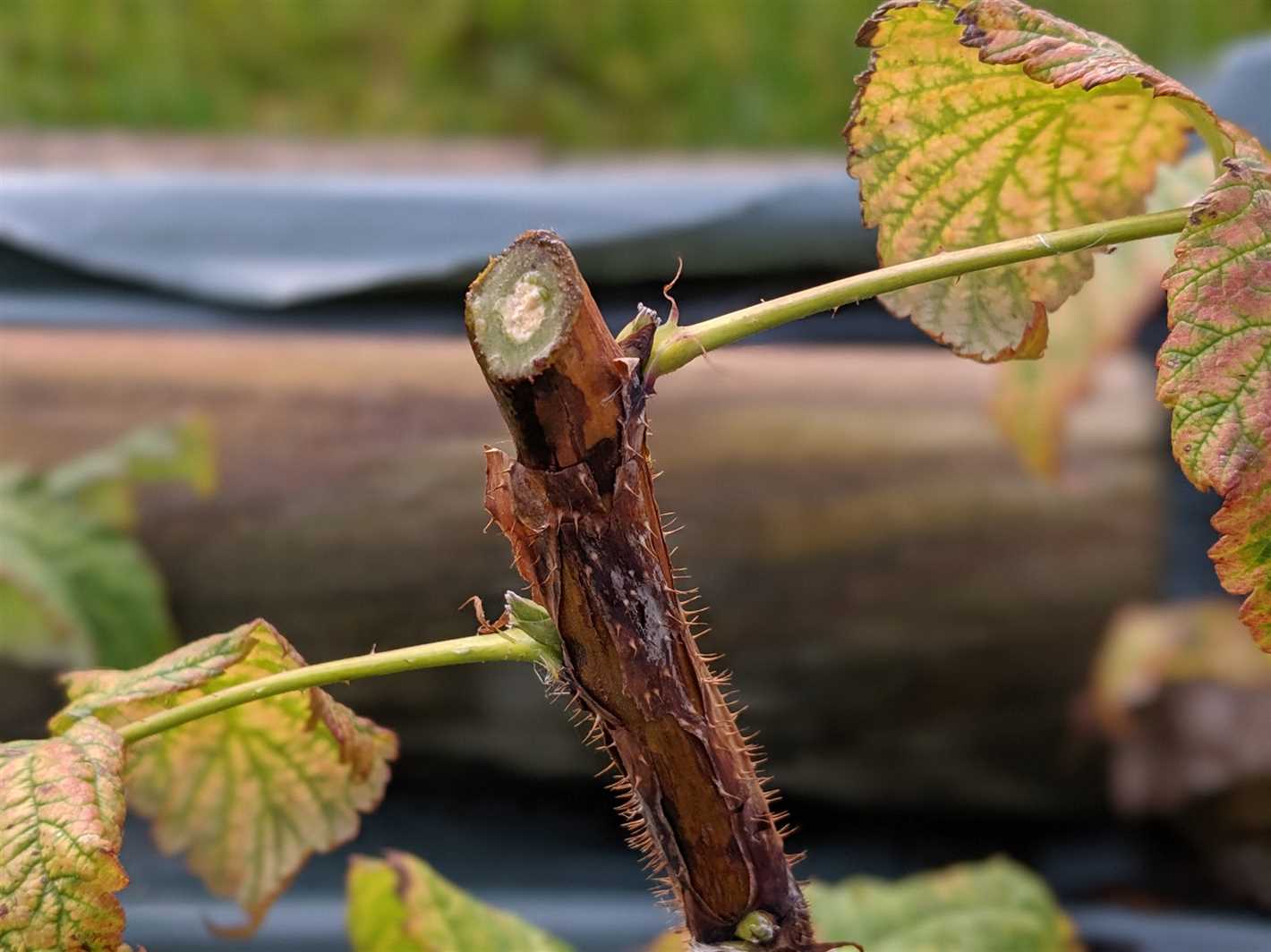
Choosing the Right Variety
Before planting raspberries in the autumn, it is important to choose the right variety for your garden. Consider factors such as climate, soil type, and available space. Some popular varieties for autumn planting include Autumn Bliss, Heritage, and Joan J.
Preparing the Soil
Preparing the soil is crucial to ensure the success of your raspberry plants. Start by removing any weeds, rocks, or debris from the planting area. Raspberries prefer well-draining soil, so it is a good idea to incorporate organic matter such as compost or well-rotted manure to improve the soil structure.
Planting
When planting raspberries in autumn, it is important to follow these steps:
- Dig a planting hole that is deep enough to accommodate the roots of the raspberry plant.
- Place the raspberry plant in the hole, making sure the roots are spread out and not cramped.
- Backfill the hole with soil and gently firm it around the plant.
- Water the newly planted raspberry thoroughly to help settle the soil and establish the plant.
Spacing
To allow proper air circulation and easy access for harvesting, it is recommended to space your raspberry plants at least 2-3 feet apart in rows. If planting multiple rows, leave about 6-8 feet of space between rows.
Support
Raspberries are cane-growing plants and require support to prevent them from falling over. You can provide support by installing a trellis, fence, or stakes. It is a good idea to install the support system before planting the raspberries to avoid damaging the roots.
Watering and Mulching
After planting, raspberries should be watered regularly to keep the soil consistently moist. Applying a layer of mulch around the plants can help retain moisture and prevent weed growth. Avoid overwatering as excessive moisture can lead to root rot.
Harvesting
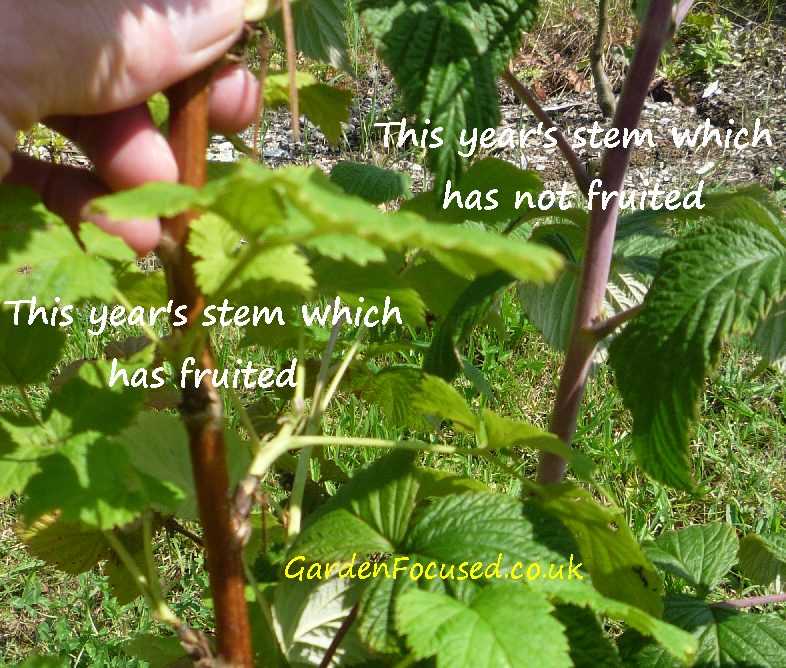
Raspberries planted in autumn usually begin to produce fruit in the following summer. Harvest the raspberries when they are fully ripe, as indicated by their vibrant color and easily separating from the plant with a gentle tug. Enjoy your freshly picked raspberries as a tasty treat or use them in various culinary recipes.
Maintenance and Pruning
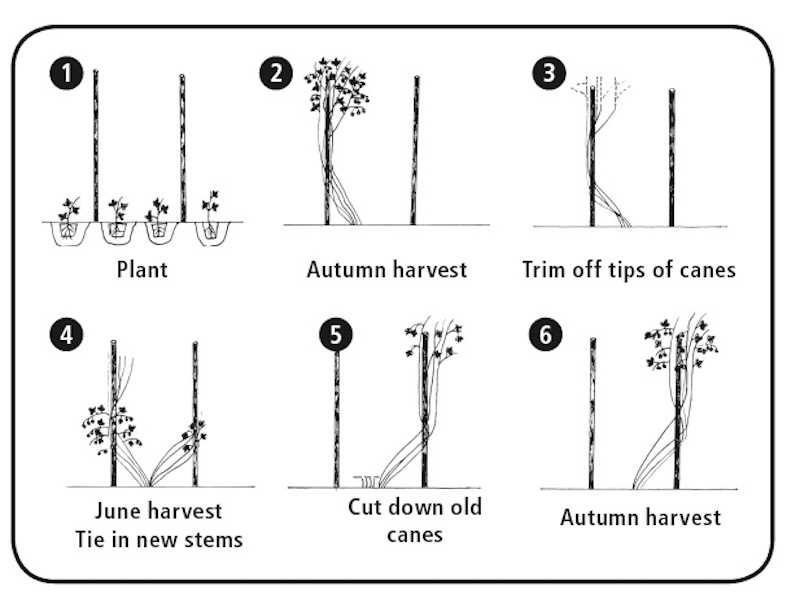
Regular maintenance and pruning are essential for healthy raspberry plants. Cut back any dead or damaged canes in late winter or early spring. Additionally, thin out overcrowded canes to promote airflow and ensure better fruit development.
Pest and Disease Control
Keep an eye out for common pests and diseases such as aphids, spider mites, and raspberry cane blight. Regular inspection and early detection can help prevent infestations and maintain the health of your raspberry plants. If necessary, use organic or chemical methods to control pests or treat diseases.
Conclusion
Planting raspberries in autumn can be a rewarding experience. With proper variety selection, soil preparation, and care, you can enjoy a bountiful harvest of delicious raspberries for years to come.
Caring for Raspberries in Autumn
Autumn is an important time for caring for your raspberry plants. Proper care during this season will help ensure a healthy and bountiful harvest the following year. Here are some essential steps to take when caring for raspberries in autumn:
1. Clearing the Area
Start by clearing away any weeds or debris around your raspberry plants. This will help prevent the spread of diseases and pests. Use a garden rake or hoe to remove any unwanted vegetation.
2. Pruning
Pruning is essential for maintaining the health and productivity of your raspberry plants. Remove any dead or diseased canes, as well as any weak or spindly growth. Cut them back to ground level using sharp pruning shears.
Leave the strongest and healthiest canes, typically those that are around 1-2 years old. These canes will produce the best fruit the following year. Trim them back to about 4-5 feet in height to encourage stronger growth.
3. Fertilizing
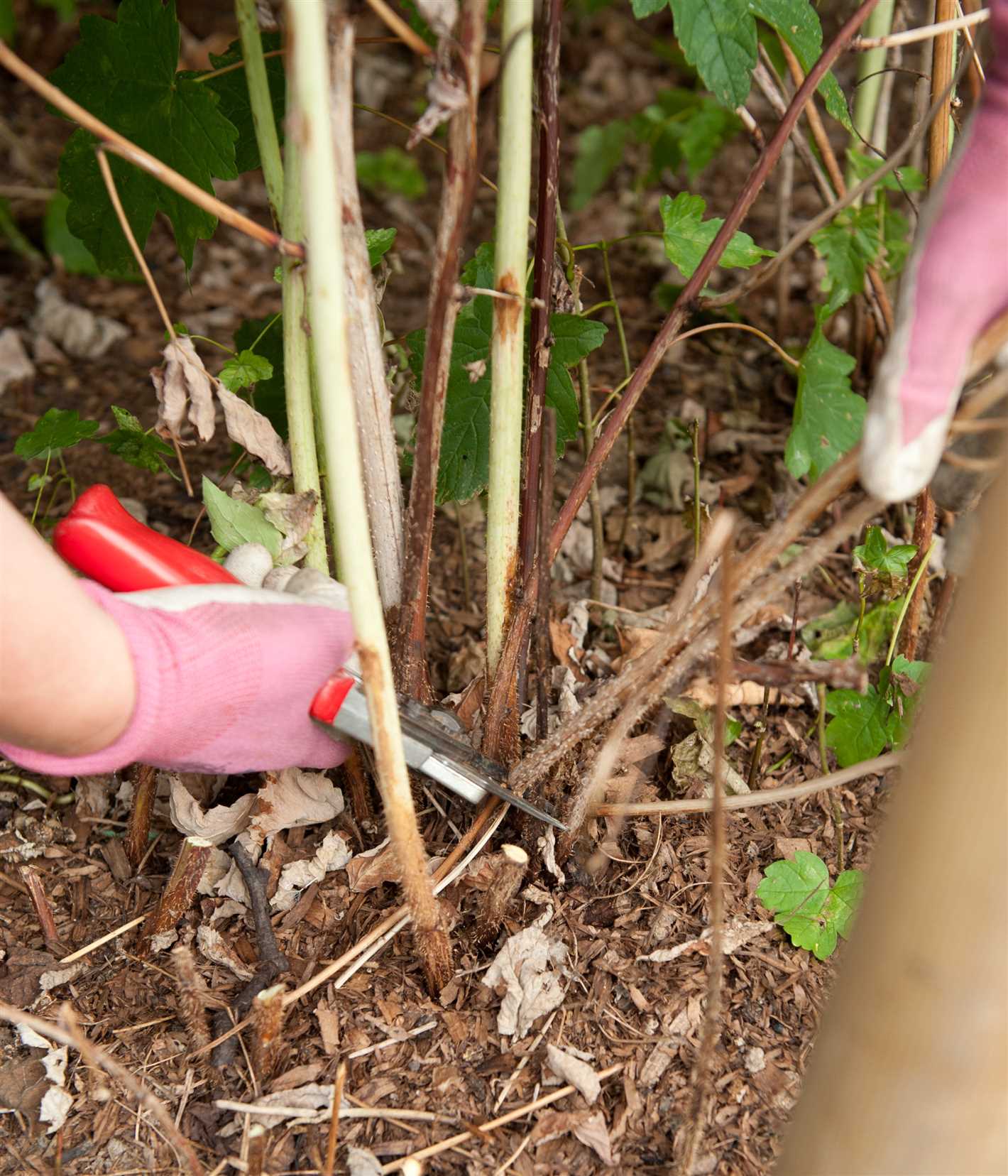
Raspberries benefit from a balanced fertilizer application in autumn. Apply a slow-release fertilizer around the base of each plant, following the manufacturer’s instructions. This will provide essential nutrients to the soil and promote healthy growth.
4. Mulching

Applying a layer of mulch around your raspberry plants can help protect them during the winter months. Use organic mulch, such as straw or wood chips, and spread it around the base of the plants. This will help insulate the soil, regulate temperature, and prevent weed growth.
5. Winter Protection
Consider providing some additional protection for your raspberry plants during the coldest months of winter. You can use burlap or frost blankets to create a barrier against harsh winds and freezing temperatures. Be sure to remove the coverings once the weather warms up in spring.
6. Watering
Continue to water your raspberry plants regularly in the autumn, especially during dry spells. Adequate moisture is essential for the establishment of new growth and the development of strong root systems. Water deeply and thoroughly to ensure the soil is moistened to a depth of at least 6 inches.
7. Cleaning and Storing Garden Tools
Before putting away your gardening tools for the winter, take the time to clean and sanitize them. Remove any dirt or debris, and wash them with warm soapy water. This will help prevent the spread of diseases to your plants in the following season.
By following these care tips, you can ensure the health and productivity of your raspberry plants and look forward to a successful harvest in the coming year.
Pruning Raspberries for a Healthy Harvest
Pruning is an essential step in caring for raspberries plants. Proper pruning not only helps maintain the health and shape of the plants, but it also promotes better fruit production. Here are some tips on how to prune raspberries for a healthy harvest:
1. Prune in the late winter or early spring
The best time to prune raspberries is in the late winter or early spring before new growth begins. This allows the plant to allocate its energy to the remaining canes and produce larger, healthier berries.
2. Remove old and diseased canes
Start by removing any dead, damaged, or diseased canes. These canes are usually dry, discolored, or show signs of disease or pest infestation. Pruning them ensures that the healthy canes receive enough nutrients and sunlight.
3. Thin out overcrowded canes
Raspberries tend to produce a lot of new canes each year, which can result in overcrowding. Thin out the canes by removing the weakest and least productive ones. This allows for better air circulation and light penetration, reducing the risk of diseases and promoting better berry development.
4. Cut back lateral branches
Once you have thinned out the canes, you can also prune the lateral branches. Cut back the lateral branches to about 12-18 inches long. This promotes the growth of new shoots and encourages the development of more fruit-bearing laterals.
5. Train the canes
Raspberries can be trained to grow in a trellis or support system. As you prune, make sure to tie the canes to the trellis or support wires to keep them upright and organized. This makes it easier to manage the plants and improves air circulation.
6. Clean up and mulch
After pruning, clean up any debris or pruned canes from around the plants to reduce the risk of pests and diseases. Apply a layer of mulch around the base of the plants to help retain moisture and suppress weed growth.
By following these pruning tips, you can ensure that your raspberry plants stay healthy and productive, resulting in a bountiful harvest of delicious berries.
Troubleshooting Common Raspberry Problems
1. Yellowing Leaves
Yellowing leaves on raspberries can be a sign of nutrient deficiency, particularly a lack of nitrogen or magnesium. To remedy this, you can apply a balanced fertilizer or a specific nutrient supplement according to the manufacturer’s instructions. Additionally, aerating the soil and improving drainage can help prevent nutrient deficiencies.
2. Wilting or Drooping Canes
If your raspberry canes are wilting or drooping, it may be due to insufficient water or excessively dry soil. Make sure your raspberry plants are getting enough water, especially during hot and dry weather. Mulching around the base of the plants can also help conserve moisture in the soil.
3. Leaves with Tattered Edges
If you notice leaves with tattered edges, it is likely a sign of damage from pests such as beetles, aphids, or caterpillars. Inspect your plants regularly and treat any infestations with an appropriate insecticide or organic pest control method to prevent further damage.
4. Mold or Fungal Disease
Raspberries are prone to fungal diseases such as powdery mildew and gray mold. To prevent these diseases, ensure proper air circulation by pruning and thinning out dense foliage. Remove and dispose of any infected plant material. If necessary, apply a fungicide according to the instructions to control the spread of the disease.
5. Lack of Fruit Production
If your raspberry plants are not producing fruit, it may be due to inadequate pollination. Consider attracting beneficial insects such as bees to your garden by planting flowers or using insect-friendly practices. You can also manually transfer pollen from the male to the female flowers using a small brush. Additionally, ensure your raspberry plants are receiving adequate sunlight and water.
6. Small or Misshapen Berries
Small or misshapen berries can be caused by several factors, including inadequate pollination, nutrient deficiencies, or pests. Provide proper pollination conditions as mentioned earlier. Ensure your plants are getting adequate nutrients through fertilization. Pest control measures should also be taken to prevent damage to developing berries.
7. Stunted Growth
If your raspberry plants are experiencing stunted growth, it may be due to poor soil quality or overcrowding. Check the soil pH and make any necessary adjustments to ensure it is within the appropriate range for raspberries. Thin out overcrowded plants to allow each plant more space and resources.
8. Yellow or Brown Spots on Leaves
Yellow or brown spots on raspberry leaves can be a sign of leaf spot disease. Remove and dispose of infected leaves and provide adequate air circulation by pruning and thinning out dense foliage. Applying a fungicide may be necessary to control the spread of the disease.
Question-answer:
When is the best time to plant raspberries?
The best time to plant raspberries is in the autumn, between October and November. Planting them in the autumn allows the roots to establish themselves over the winter months before the spring growth begins.
How do I care for raspberries in the autumn?
In the autumn, you should prepare the soil by removing any weeds and adding compost or well-rotted manure. You should also prune the canes that have fruited and remove any dead or diseased canes. Additionally, you can mulch around the base of the plants to protect them from the cold weather.
Why is autumn planting beneficial for raspberries?
Autumn planting is beneficial for raspberries because it allows the roots to establish themselves over the winter months, which results in stronger and healthier plants in the spring. It also gives the plants a head start, allowing them to produce fruit earlier in the following year.
When should I prune my raspberry plants?
Raspberry plants should be pruned in the autumn after they have finished fruiting. It’s important to remove the canes that have produced fruit, as they will not produce fruit again. You should also remove any dead or diseased canes to maintain the health of the plants.
How should I prune my raspberry plants?
To prune raspberry plants, start by removing the canes that have produced fruit, cutting them back to ground level. Next, remove any dead or diseased canes by cutting them at the base. Finally, trim the remaining canes to a height of around 5-6 feet to encourage new growth in the spring.







